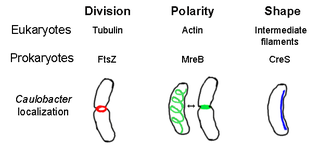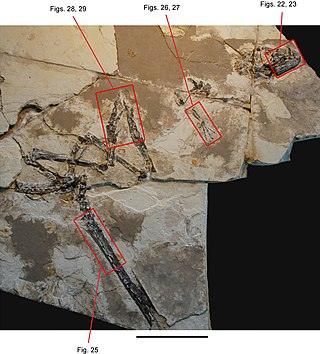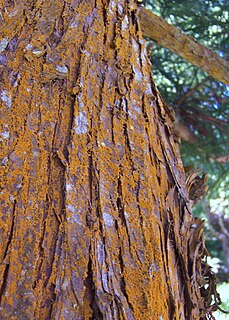
Keratin is one of a family of fibrous structural proteins. It is the key structural material making up hair, nails, horns, claws, hooves, and the outer layer of human skin. Keratin is also the protein that protects epithelial cells from damage or stress. Keratin is extremely insoluble in water and organic solvents. Keratin monomers assemble into bundles to form intermediate filaments, which are tough and form strong unmineralized epidermal appendages found in reptiles, birds, amphibians, and mammals. The only other biological matter known to approximate the toughness of keratinized tissue is chitin.

Microfilaments, also called actin filaments, are filaments in the cytoplasm of eukaryotic cells that form part of the cytoskeleton and are primarily composed of polymers of actin, but in cells are modified by and interact with numerous other proteins. Microfilaments are usually about 7 nm in diameter and composed of two strands of actin. Microfilament functions include cytokinesis, amoeboid movement and cell motility in general, changes in cell shape, endocytosis and exocytosis, cell contractility and mechanical stability. Microfilaments are flexible and relatively strong, resisting buckling by multi-piconewton compressive forces and filament fracture by nanonewton tensile forces. In inducing cell motility, one end of the actin filament elongates while the other end contracts, presumably by myosin II molecular motors. Additionally, they function as part of actomyosin-driven contractile molecular motors, wherein the thin filaments serve as tensile platforms for myosin's ATP-dependent pulling action in muscle contraction and pseudopod advancement. Microfilaments have a tough, flexible framework which helps the cell in movement.
The word filament, which is descended from Latin filum meaning "thread", is used in English for a variety of thread-like structures, including:
Fragmentation in multicellular organisms is a form of asexual reproduction in which an organism is split into fragments. Each of these fragments develop into matured, fully grown individuals that are identical to their parents.

Biological soil crusts are communities of living organisms on the soil surface in arid and semi-arid ecosystems. They are found throughout the world with varying species composition and cover depending on topography, soil characteristics, climate, plant community, microhabitats, and disturbance regimes. Biological soil crusts perform important ecological roles including carbon fixation, nitrogen fixation and soil stabilization; they alter soil albedo and water relations and affect germination and nutrient levels in vascular plants. They can be damaged by fire, recreational activity, grazing and other disturbances and can require long time periods to recover composition and function. Biological soil crusts are also known as cryptogamic, microbiotic, microphytic, or cryptobiotic soils.
Filamentation is the anomalous growth of certain bacteria, such as E. coli, in which cells continue to elongate but do not divide. The cells that result from elongation without division have multiple chromosomal copies. Bacterial filamentation is often observed as a result of bacteria responding to various stresses, including DNA damage or inhibition of replication. This may happen, for example, while responding to extensive DNA damage through the SOS response system. Nutritional changes may also cause bacterial filamentation. Some of the key genes involved in filamentation in E.coli include sulA and minCD. The following genes have been connected to virulence using the G. mellonella infection model: BCR1,FLO8, KEM1, SUV3 and TEC1. These genes are required for biofilm development from filamentation. Filamentation properties are argued to be necessary in virulence. The biofilm of bacteria is also connected to the organism’s virulence. Filamentation is a survival strategy that protects bacteria from stressors such as host effectors and protist predators. The strategy of filamentation is known to protect bacteria from antibiotic medicines taken by the host.
Septins are a group of GTP-binding proteins expressed in all eukaryotic cells except plants. Different septins form protein complexes with each other. These complexes can further assemble into filaments, rings and gauzes. Assembled as such, septins function in cells by localizing other proteins, either by providing a scaffold to which proteins can attach, or by forming a barrier preventing the diffusion of molecules from one compartment of the cell to another, or in the cell cortex as a barrier to the diffusion of membrane-bound proteins.

Conceptacles are specialised cavities of marine and freshwater algae that contain the reproductive organs. They are situated in the receptacle and open by a small ostiole. Conceptacles are present in Corallinaceae, and Hildenbrandiales, as well as the brown Fucales. In the Fucales there is no haploid phase in the reproductive cycle and therefore no alternation of generations. The thallus is a sporophyte. The diploid plants produce male (antheridia) and female (oogonia) gametangia by meiosis. The gametes are released into the surrounding water; after fusion, the zygote settles and begins growth.

The prokaryotic cytoskeleton is the collective name for all structural filaments in prokaryotes. It was once thought that prokaryotic cells did not possess cytoskeletons, but advances in visualization technology and structure determination led to the discovery of filaments in these cells in the early 1990s. Not only have analogues for all major cytoskeletal proteins in eukaryotes been found in prokaryotes, cytoskeletal proteins with no known eukaryotic homologues have also been discovered. Cytoskeletal elements play essential roles in cell division, protection, shape determination, and polarity determination in various prokaryotes.
This glossary of botanical terms is a list of terms relevant to botany and plants in general. Terms of plant morphology are included here as well as at the related Glossary of plant morphology and Glossary of leaf morphology. See also List of Latin and Greek words commonly used in systematic names. You can help by adding illustrations that assist an understanding of the terms.

Tianyulong was a genus of heterodontosaurid ornithischian dinosaur. The only species was T. confuciusi, whose remains were discovered in Jianchang County, Western Liaoning Province, China.
Actin remodeling is the biochemical process that allows for the dynamic alterations of cellular organization. The remodeling of actin filaments occurs in a cyclic pattern on cell surfaces and exists as a fundamental aspect to cellular life. During the remodeling process, actin monomers polymerize in response to signaling cascades that stem from environmental cues. The cell's signaling pathways cause actin to affect intracellular organization of the cytoskeleton and often consequently, the cell membrane. Again triggered by environmental conditions, actin filaments break back down into monomers and the cycle is completed. Actin-binding proteins (ABPs) aid in the transformation of actin filaments throughout the actin remodeling process. These proteins account for the diverse structure and changes in shape of Eukaryotic cells. Despite its complexity, actin remodeling may result in complete cytoskeletal reorganization in under a minute.
Bacterial morphological plasticity refers to changes in the shape and size that bacterial cells undergo when they encounter stressful environments. Although bacteria have evolved complex molecular strategies to maintain their shape, many are able to alter their shape as a survival strategy in response to protist predators, antibiotics, the immune response, and other threats.
Filamentous carbon is a carbon-containing deposit structure that refers to several allotropes of carbon, including carbon nanotubes, carbon nanofibers, and microcoils. It forms from gaseous carbon compounds. Filamentous carbon structures all contain metal particles. These are either iron, cobalt, or nickel or their alloys. Deposits of it also significantly disrupt synthesis gas methanation. Acetylene is involved in a number of method of the production of filamentous carbon. The structures of filamentous carbon are mesoporous and on the micrometer scale in dimension. Most reactions that form the structures take place at or above 280 °C (536 °F).

A fruticose lichen is a form of lichen fungi that is characterized by a coral-like shrubby or bushy growth structure. It is composed of a thallus and a holdfast. It is formed from a symbiotic relationship of a photobiont such as cyanobacteria and two mycobionts. Fruticose lichen is composed of a complex vegetation structure, and characterized by an ascending, bushy or pendulous appearance. While lichen communities are mainly controlled by water and light, vegetative dispersal and filamentous growth in fruticose lichen is often associated with areas of low elevation. Fruticose lichens can endure high degrees of desiccation. They grow very slowly and will often occur in extreme habitats such as on tree barks, on rock surfaces and on soils in the Arctic and mountain regions.
A Byssoid lichen is a lichen with a wispy growth form, having the appearance of teased wool. Coenogonium implexum is a byssoid lichen.

Lichens are grouped by common lichen growth forms. There are a wide range of growth forms (morphology). These groupings may not be consistent with lichen taxonomy, since lichens with similar growth forms are not necessarily related by ancestry. Groups based on growth may overlap and have borderline cases. A species usually has the same overall growth form wherever it is found, but not always.
Calothrix crustacea is a species of bacteria that is widespread in oceans worldwide.










